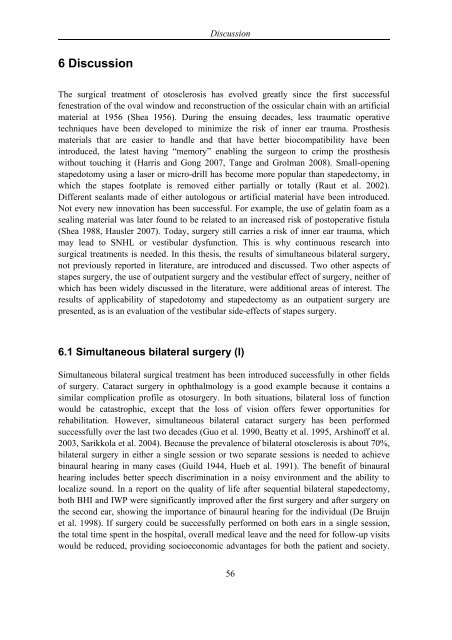Modern surgical treatment of otosclerosis - Helda - Helsinki.fi
Modern surgical treatment of otosclerosis - Helda - Helsinki.fi
Modern surgical treatment of otosclerosis - Helda - Helsinki.fi
Create successful ePaper yourself
Turn your PDF publications into a flip-book with our unique Google optimized e-Paper software.
6 Discussion<br />
Discussion<br />
The <strong>surgical</strong> <strong>treatment</strong> <strong>of</strong> <strong>otosclerosis</strong> has evolved greatly since the <strong>fi</strong>rst successful<br />
fenestration <strong>of</strong> the oval window and reconstruction <strong>of</strong> the ossicular chain with an arti<strong>fi</strong>cial<br />
material at 1956 (Shea 1956). During the ensuing decades, less traumatic operative<br />
techniques have been developed to minimize the risk <strong>of</strong> inner ear trauma. Prosthesis<br />
materials that are easier to handle and that have better biocompatibility have been<br />
introduced, the latest having “memory” enabling the surgeon to crimp the prosthesis<br />
without touching it (Harris and Gong 2007, Tange and Grolman 2008). Small-opening<br />
stapedotomy using a laser or micro-drill has become more popular than stapedectomy, in<br />
which the stapes footplate is removed either partially or totally (Raut et al. 2002).<br />
Different sealants made <strong>of</strong> either autologous or arti<strong>fi</strong>cial material have been introduced.<br />
Not every new innovation has been successful. For example, the use <strong>of</strong> gelatin foam as a<br />
sealing material was later found to be related to an increased risk <strong>of</strong> postoperative <strong>fi</strong>stula<br />
(Shea 1988, Hausler 2007). Today, surgery still carries a risk <strong>of</strong> inner ear trauma, which<br />
may lead to SNHL or vestibular dysfunction. This is why continuous research into<br />
<strong>surgical</strong> <strong>treatment</strong>s is needed. In this thesis, the results <strong>of</strong> simultaneous bilateral surgery,<br />
not previously reported in literature, are introduced and discussed. Two other aspects <strong>of</strong><br />
stapes surgery, the use <strong>of</strong> outpatient surgery and the vestibular effect <strong>of</strong> surgery, neither <strong>of</strong><br />
which has been widely discussed in the literature, were additional areas <strong>of</strong> interest. The<br />
results <strong>of</strong> applicability <strong>of</strong> stapedotomy and stapedectomy as an outpatient surgery are<br />
presented, as is an evaluation <strong>of</strong> the vestibular side-effects <strong>of</strong> stapes surgery.<br />
6.1 Simultaneous bilateral surgery (I)<br />
Simultaneous bilateral <strong>surgical</strong> <strong>treatment</strong> has been introduced successfully in other <strong>fi</strong>elds<br />
<strong>of</strong> surgery. Cataract surgery in ophthalmology is a good example because it contains a<br />
similar complication pr<strong>of</strong>ile as otosurgery. In both situations, bilateral loss <strong>of</strong> function<br />
would be catastrophic, except that the loss <strong>of</strong> vision <strong>of</strong>fers fewer opportunities for<br />
rehabilitation. However, simultaneous bilateral cataract surgery has been performed<br />
successfully over the last two decades (Guo et al. 1990, Beatty et al. 1995, Arshin<strong>of</strong>f et al.<br />
2003, Sarikkola et al. 2004). Because the prevalence <strong>of</strong> bilateral <strong>otosclerosis</strong> is about 70%,<br />
bilateral surgery in either a single session or two separate sessions is needed to achieve<br />
binaural hearing in many cases (Guild 1944, Hueb et al. 1991). The bene<strong>fi</strong>t <strong>of</strong> binaural<br />
hearing includes better speech discrimination in a noisy environment and the ability to<br />
localize sound. In a report on the quality <strong>of</strong> life after sequential bilateral stapedectomy,<br />
both BHI and IWP were signi<strong>fi</strong>cantly improved after the <strong>fi</strong>rst surgery and after surgery on<br />
the second ear, showing the importance <strong>of</strong> binaural hearing for the individual (De Bruijn<br />
et al. 1998). If surgery could be successfully performed on both ears in a single session,<br />
the total time spent in the hospital, overall medical leave and the need for follow-up visits<br />
would be reduced, providing socioeconomic advantages for both the patient and society.<br />
56

















